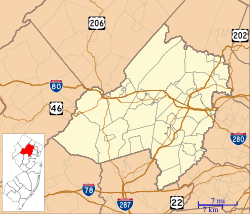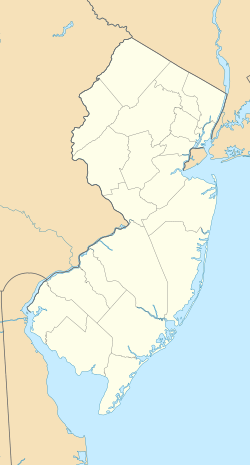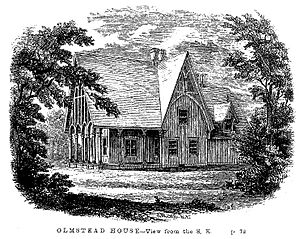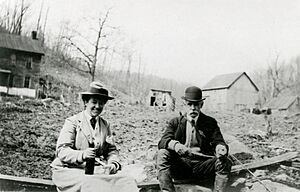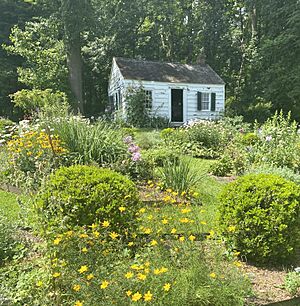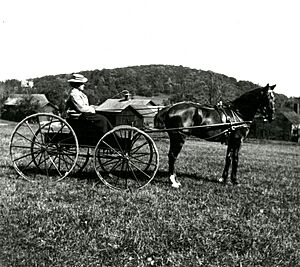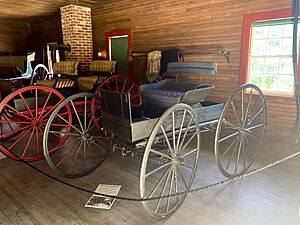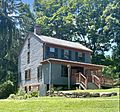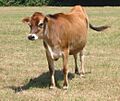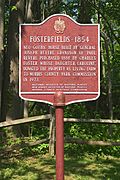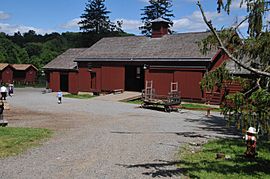Fosterfields facts for kids
|
Fosterfields
|
|
|
U.S. Historic district
Contributing property |
|
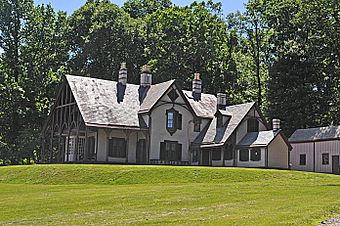
Joseph W. Revere House
|
|
| Location | Junction of Mendham and Kahdena Roads, Morris Township, New Jersey |
|---|---|
| Area | 213.4 acres (86.4 ha) |
| Built | 1854 |
| Architect | Joseph Warren Revere |
| Architectural style | Gothic Revival style |
| Part of | Washington Valley Historic District (ID92001583) |
| NRHP reference No. | 73001127 (original) 91000478 (increase) |
Quick facts for kids Significant dates |
|
| Added to NRHP | September 20, 1973 |
| Boundary increase | October 9, 1991 |
| Designated CP | November 12, 1992 |
Fosterfields, also known as Fosterfields Living Historical Farm, is a 213.4-acre farm and museum in Morris Township, New Jersey. It's a special place where you can see what farm life was like around the 1920s. The oldest building on the farm, called the Ogden House, was built way back in 1774.
Fosterfields is important for its history, art, and architecture. It was added to the National Register of Historic Places in 1973. The farm was once owned by Joseph Warren Revere, who was the grandson of the famous Paul Revere. He built a beautiful mansion called "The Willows" in 1854.
Later, in 1881, a man named Charles Grant Foster bought the property. He turned it into a successful Jersey cattle farm and named it "Fosterfields." His daughter, Caroline Rose Foster, lived and worked on the farm for 98 years. She loved carpentry, fishing, and being involved in her community.
In 1974, Caroline Foster decided to give the farm to the Morris County Park Commission. She wanted it to become an educational farm for everyone to learn from. After she passed away in 1979, the farm officially became a museum. Fosterfields is also part of the Washington Valley Historic District.
Contents
A Look Back in Time: Fosterfields History
Early Days with the Lenape People
Around 1000 years ago, the land where Fosterfields now stands was home to the Munsee Lenape people. This area was part of their larger territory called Lenapehoking. They were skilled hunters, catching animals like wolf, elk, and wild turkey. They also gathered mussels from the nearby Whippany River.
The Lenape farmers likely grew corn in the fields during the summer. They also traveled to Minisink Island on the Delaware River to gather shellfish. In the 1700s, many Lenape families moved from the Washington Valley to other areas.
The Ogden Farm and the Revolutionary War
Around the 1750s, Samuel Roberts owned a large piece of land in Washington Valley. In 1774, he gave 150 acres to his stepson, Jonathan Ogden, as a wedding gift. Ogden built a farmhouse on this land, which is now the oldest structure at Fosterfields.
Jonathan Ogden was an important person in the community. He was a county judge and even represented Morris County in the New Jersey Legislature. The original Ogden farmhouse burned down in 1915, but its 1774 stone foundation is still there. A new house was built on the same spot, looking just like the old one.
Revolutionary War Connections
During the American Revolutionary War, the winter of 1779–1780 was very cold. General Washington and his army were stationed nearby. Henry Knox, a general in Washington's army, may have used the Ogden farmhouse as his home and headquarters. Both Samuel Roberts and Jonathan Ogden fought in the war.
Life at the Ogden Farm
From 1918 to 1927, the Woods family lived in the Ogden house. Edward Woods was the farm superintendent, and his wife Agnes cooked for the farmhands. The house didn't have running water back then, so they had to pump water by hand. Agnes Woods cooked family recipes on a wood stove, including tasty pasties that she carried to the workers in the fields. Today, you can still see the functional wood stove at the farm.
The Willows Mansion
"The Willows" is a beautiful mansion built by Joseph Warren Revere. He bought the Ogden Farm in 1852 for $6,000. Revere was a naval officer and the grandson of Paul Revere. He had traveled all over the world before deciding to settle in New Jersey.
Building a Dream Home
Revere wanted a special home, so he designed a new mansion. It was named "The Willows" because of the many willow trees around it. He chose a spot overlooking the farm and hired a local carpenter, Ashbel Bruen, to build it. The mansion was built in the Gothic Revival style, which looks a bit like old castles.
Construction took place from 1852 to 1854. While it was being built, the Revere family lived in the Ogden house. Revere was also an artist. He painted amazing trompe l'oeil murals in the dining room. These paintings make flat surfaces look like they have depth and real objects.
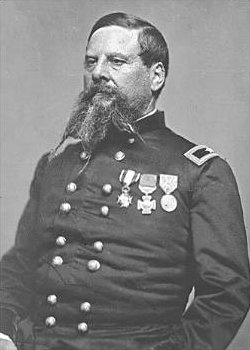
In 1861, Revere joined the Union military during the Civil War. He became a general. After the war, he rented out The Willows to tenants. One famous tenant was the author Bret Harte, who wrote a novel inspired by his time in Morristown.
The Foster Family and a Modern Farm
In 1881, Charles Grant Foster, a broker from New York, bought The Willows after Revere's death. He was a "gentleman farmer," meaning he managed the farm while also working in the city. He and his family lived in The Willows.
Charles Foster wanted to create a top-notch dairy farm. In 1882, he started importing purebred Jersey cows from the British Isle of Jersey. By 1883, his herd had about 70 cows. He used new farming technologies like ensilage pits to feed his cows in winter and steam-engine fodder choppers.
Foster kept a daily farm journal for 40 years. He also advertised his Jersey cattle in farming magazines, selling cows, heifers, and bulls. His daughter, Caroline Foster, helped with the farm. She even traveled to the Isle of Jersey to buy cows.
Caroline Foster's Temple of Abiding Peace
In 1916, Caroline Foster started building a small, one-room cottage outside The Willows. She was skilled in carpentry and built it herself. In 1919, she finished the cottage and named it "The Temple of Abiding Peace." It was a quiet place for her to relax, entertain guests, and make birdhouses. She also planted a beautiful garden around it.
In 1925, most of the Jersey cattle were sold because Charles Foster's health was failing. After his death in 1927, Caroline Foster took over the farm. She continued to sell milk, eggs, butter, vegetables, and honey. In 1928, she bought a gasoline-powered tractor, a big step up from using draft horses.
In 1937, Caroline Foster brought electricity to The Willows and the Ogden farmhouse. She continued to be involved with the farm well into her 90s. The Temple of Abiding Peace opened to the public as part of the museum in 1999.
Fosterfields Living Historical Farm Museum
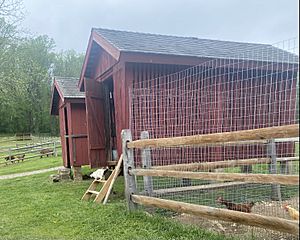
Fosterfields is New Jersey's first living historical farm. It's a place where you can experience what farm life was like in the early 20th century, specifically from the 1880s to the 1930s.
Caroline Foster wanted the farm to be preserved for education. In her will, she asked that the property be kept simple and natural. She wanted it to be an educational and historical place, not just for fun or selling food.
What You Can See and Do
At Fosterfields, you can see antique farm machinery, like old steam engines and butter churns. You can watch farmers plowing fields and learn about historical farming methods. Tour guides help you understand what life was like for the Foster family in The Willows and the Woods family in the Ogden House.
Visitors can also help with daily farm tasks. You might collect eggs, clean horse harnesses, or grind corn for the chickens. It's a hands-on way to learn about farm life!
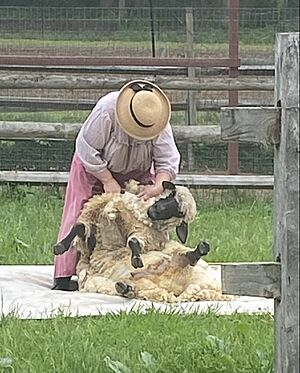
The farm is home to many heritage breeds of animals, including:
- Jersey cows
- Different kinds of chickens like Buff Orpington and Rhode Island Red
- Oberhasli goats
- Cayuga ducks
- African geese
- Shropshire rams and mixed Leicester/Romney sheep
Fosterfields often hosts special events. In May 2021 and May 2022, they had a "Born to be Shorn" event where a guest expert showed how to shear sheep. In February 2022, "Winter's Day" invited guests to try ice cutting, maple tree tapping, and outdoor cooking. They also celebrate "Model T Ford Day" to show off old cars and teach guests how to drive them.
Transportation Exhibit
Caroline Foster also wanted her collection of carriages, wagons, and antique cars to be displayed. Today, you can see her 1922 Model T Ford and a 1929 Hupmobile in the Fosterfields Visitors Center. This exhibit is called "Driving Into the Twentieth Century." Her horse-drawn carriages are in the Carriage House next to the barn.
Making History Accessible
In 2022, students from the County College of Morris created a special virtual reality exhibit. It lets people explore the second floor of The Willows, which isn't accessible by wheelchair due to its narrow staircase. Using 3D modeling and 360-degree cameras, they made a virtual tour. This way, everyone can experience the history of the mansion.
Images for kids
-
Author Bret Harte rented The Willows.
-
Purebred Jersey cows were important to Charles G. Foster's farm.
Gallery
See also
- Acorn Hall, a nearby Morristown historic house museum
- Washington Valley Historic District
- Howell Living History Farm
- Longstreet Farm


